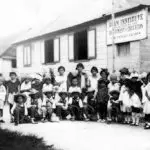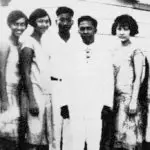Nieves M. Flores



Table of Contents
Share This
Molded island leaders
In 1985, 96 years after his birth on 5 August 1889, in the capital city of Laoag in the province of Ilocos Norte, Philippines, Nieves Mariano Flores was inducted into the Hall of Fame of the international fraternity of professional educators, Phi Delta Kappa, for devoting more than 20 years of his life to education.
Nieves Flores (1889 – 1949) was more than a Guam educator—he was a prominent civic leader, an attorney, and a land surveyor—yet remarkably, little is published about the man who molded some of the island’s most talented people, often under austere conditions.
Nieves Flores attended a private Spanish school in Laoag before moving to Manila. At Manila High School he studied surveying and was a classmate of Manual Roxas, who became the first president of the newly independent Republic of the Philippines from 1946 to 1952. Flores furthered his surveying studies at the Trade School of the Philippines before being recruited in 1914 by the US Naval government in Guam to conduct the ongoing cadastral land survey initiated by Governor George L. Dyer in 1905.
Two years later, in 1916, Flores was not only the Navy’s deputy surveyor, but he was also Guam’s Deputy Attorney. For the next seven years, Flores attempted, though unsuccessfully, to survey Hagåtña and the surrounding areas; periodic cadastral surveys continued but were rendered virtually useless given the lack of accurate information.
Land surveys conducted during the terms of Naval governors William J. Maxwell, from 1914 to 1916, and Roy C. Smith, from 1916 to 1918, continued to haunt the Naval and civilian governments years later. As stated in historian Robert Rogers Destiny’s Landfall: A History of Guam, the land surveys showed the Naval government’s record of:
…poor land management, questionable tax assessments and condemnations, massive court litigation, and huge real estate swindles [that] would occur in the decades ahead as consequences of inadequate cadastral information.
Prior to the American recapture of Guam between 21 July and 10 August 1944, as military planners pondered on the best invasion site, Major Frank O. Hough, U.S. Marine Corps stated:
…that the only overall survey of the island had been done by an engineering unit from the Philippines in 1916 (headed by Nieves Flores).
While performing a dual professional life in the Naval government, Flores married Guadalupe Alcantara Cruz on 11 November 1916 at Sumai. Flores’s marriage to Guadalupe was the first of three marriages. Guadalupe died four years later of unknown causes at the age of 25. The union produced two sons—Alexis and Sabino. After World War II, Alexis graduated from Northwestern University in 1949, one of a handful of Guamanian immediate post-war college graduates, while Sabino was the former head administrative assistant at the Island Provost Marshal’s office.
His second marriage to Rosario Untalan Flores on 18 January 1936 ended tragically as well when on 7 September 1937, she died of childbirth complications. Flores married his third wife Serafina Leon Guerrero Untalan two years later on 30 December 1939 at Hagåtña.
Begins career as educator
Plagued by marital misfortune and mixed professional success, Flores resigned his position as deputy land surveyor to embark upon a new career—education. Public education in Guam in the early 1920s was riddled with problems: there was a lack of schools and competent English teachers; continued high illiteracy rates in English among the local populace; the 1907 formal introduction of school laws that allowed two separate military schools to open; and Congressional disinterest to increase the operating budget of the Naval government.
Guam Institute
Rather than opt for public education service, Flores founded and opened (he also served as the school’s principal) the Guam Institute in 1922, a private elementary school located in two houses belonging to Castro de la Cruz of Hagåtña. Five years later, in March 1927, the first nine students of the Guam Institute graduated. In 1928, Flores moved the Guam Institute across the street to the Jose P. Lujan House, where the school flourished until December 1941.
The Guam Institute was considered the only successful private school in pre-war Guam, and by 1936, included all 12 grades. Day and evening classes were offered and special tutoring was given to public school children as well. Enrollment averaged between 150 and 200 students in those days who paid $1—and later $1.50—per month for tuition. The school’s enrollment increases year after year were partially attributed to Naval government regulations. The school had monthly visits and examinations by Naval officials and was characterized as being on par with [American] public schools.
The Institute was also successful for another reason. It offered both vocational and academic course loads to students. In the early 1930s, Governor Willis W. Bradley issued moderate reforms to the public school system curricula, including “a renewed emphasis on practical vocational guidance.” To cater to the increased enrollment, Flores had a team of 14 educators—evenly divided between academic and industrial arts—who taught some of the island’s most notable future leaders, including Governor Ricardo J. Bordallo, Archbishop Felixberto Flores, Judge Cristobal Duenas, and Judge Joaquin Perez.
On 10 December 1941, Japanese Imperial Army troops landed in Guam and forced the surrender of the Naval government. For two and a-half years, Guam was occupied by the Japanese as the horrors of World War II engulfed Europe, Asia, and the Pacific. Of the many changes experienced in Guam, one affected the Guam Institute—it was closed down, never to reopen.
Flores survived the war and returned to teaching following the lifting of martial law in Guam in 1946 at George Washington High School in Mongmong. He taught mathematics, and in his spare time, devoted himself to civic organizations, including the Holy Name Society, Agana Scout Committee, and the Filipino Club of Guam as president.
Flores died 7 June 1949 at the age of 59 of “cardiac decompensation” at his home in Julale, Hagåtña, and was survived by his wife Serafina, two sons, and numerous relatives, including attorney Leon D. Flores and Archbishop Felixberto Flores.
Three months later in September, the Guam Public Library was officially renamed the Nieves M. Flores Memorial Library through a proclamation signed by Governor Carlton Skinner. In 1949, Norbert Tabery, the director of education, recommended the name change and the library board of directors unanimously voted to approve the change.
For further reading
Caldwell, Mary Sue. “A History of the Guam Public Library System, 1947-1975.” EdD diss., Western Michigan University, 1977.
Carano, Paul, and Pedro C. Sanchez. A Complete History of Guam. Rutland: Charles E. Tuttle, Co., 1964.
Farrell, Don A. The Pictorial History of Guam: Liberation, 1944. Tamuning: Micronesian Productions, 1984.
“Flores, a 1985 Phi Delta Kappa Hall of Fame recipient.” n.p. Mimeograph. Mangilao: Micronesian Area Research Center, University of Guam, n.d.
“Nieves N. [sic] Flores GWHS Instructor Dies at Agana.” Guam News, 8 June 1949.
Rogers, Robert. Destiny’s Landfall: A History of Guam. Honolulu: University of Hawai’i Press, 1995.
Ronck, Ronn. “Notes on Micronesia.” Islander, Pacific Sunday News, 22 May 1977.
Underwood, Robert A. “American Education and the Acculturation of the Chamorros of Guam.” EdD diss., University of Southern California, 1987.
